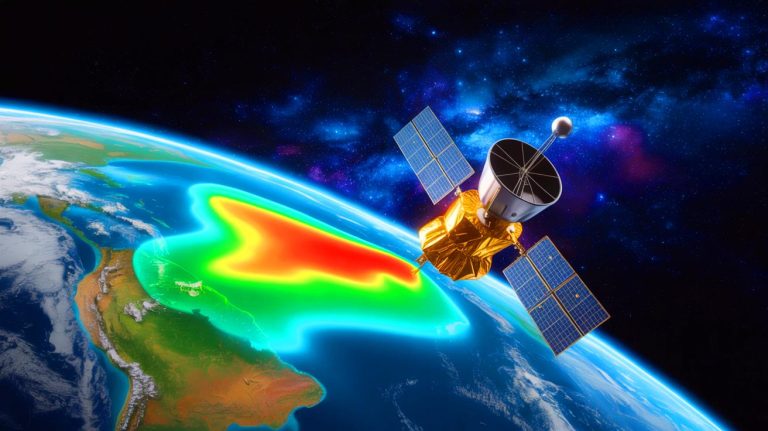| IN A NUTSHELL |
|
The South Atlantic Anomaly (SAA) presents a unique and evolving challenge for scientists and space agencies across the globe. This region, located over South America, is characterized by a weakened magnetic field, which poses significant risks to space technology. As the anomaly continues to change, understanding its implications is crucial for the safety of satellites and the advancement of our knowledge of Earth’s magnetic field. This article examines the complex origins of the SAA, its threats to space technology, its dynamic evolution, and how scientists are working to predict its future trajectory.
Understanding the Complex Origins
The South Atlantic Anomaly is a fascinating geomagnetic phenomenon marked by a significant decline in magnetic intensity. This area acts almost as a breach in Earth’s protective magnetic shield, allowing high-energy solar particles to come alarmingly close to the surface. The SAA’s formation is attributed to the complex interplay of several factors, including the tilt of Earth’s magnetic axis and the presence of the African Large Low Shear Velocity Province. This dense structure, located approximately 1,800 miles beneath Africa, disrupts the generation of the magnetic field, leading to a local polarity reversal.
At the heart of this phenomenon is the geodynamo, a dynamic process in Earth’s outer core where the movement of molten iron and nickel generates the planet’s magnetic field. The intricate interactions of these elements result in the unique characteristics of the SAA, making it a critical area of study for scientists seeking to understand Earth’s magnetic environment. By delving into these deep origins, researchers aim to uncover the profound processes shaping our planet’s magnetic dynamics.
Impact on Space Technology
The South Atlantic Anomaly poses a notable threat to space technology, as satellites traversing this region encounter high levels of energetic protons. These particles can result in single event upsets, causing temporary malfunctions, data corruption, and, in severe cases, permanent damage to spacecraft systems. To mitigate these risks, satellite operators often take precautionary measures, such as shutting down non-essential systems when passing through the anomaly.
The International Space Station (ISS), which passes through the SAA on each orbit, is also affected. Although the ISS’s shielding provides adequate protection for astronauts, external instruments remain vulnerable. Bryan Blair, the deputy principal investigator for the GEDI instrument on the ISS, has reported occasional glitches and resets, leading to data loss. Other missions, like the Ionospheric Connection Explorer (ICON), closely monitor the SAA to adjust their operations and minimize disruptions, highlighting the ongoing impact of the anomaly on space exploration.
Dynamic Evolution and Emerging Challenges
The South Atlantic Anomaly is not a static entity; it is continuously evolving. Recent observations from the ESA’s Swarm satellite constellation and historical data from NASA’s SAMPEX mission have revealed concerning trends. The anomaly is drifting northwest, expanding in size, and, notably, since 2020, splitting into two distinct lobes. This bifurcation creates dual centers of minimum magnetic intensity, increasing the number of hazardous zones for spacecraft.
This evolving morphology complicates the development of predictive models for geomagnetic conditions, necessitating continuous monitoring and adaptation in satellite operations. Terry Sabaka from NASA emphasizes that these developments require ongoing vigilance to ensure the safety of current and future satellites. Understanding the changing nature of the SAA is essential for protecting space technology and addressing the challenges posed by this dynamic anomaly.
Anticipating Future Changes
NASA employs an integrated approach to improve the understanding and prediction of the South Atlantic Anomaly. By combining satellite data with simulations of Earth’s core dynamics, scientists support global models like the International Geomagnetic Reference Field (IGRF), which track the evolution of Earth’s magnetic field. These models are crucial for planning space missions and offer insights into the planet’s internal structure.
Despite the unprecedented nature of the SAA’s current evolution in the space era, geological records suggest that similar anomalies have occurred over long timescales. Importantly, scientists assert that the current SAA is not an early indicator of a magnetic pole reversal, a rare event occurring over hundreds of thousands of years. Studying the SAA remains a vital area of research, essential for safeguarding orbiting technologies and deepening our understanding of Earth’s magnetic forces.
As the South Atlantic Anomaly continues to evolve, the scientific community remains vigilant in its efforts to understand and mitigate its impact. With its potential to disrupt satellite operations and influence our understanding of Earth’s magnetic field, the SAA poses intriguing questions about the future of our planet’s magnetic dynamics. How will these changes shape our technological and scientific pursuits in the years to come?
Did you like it? 4.5/5 (27)








This is mind-blowing! How can the ground “breathe”? 🤯
Is this just clickbait or is there real science behind it? 🤔
Thanks for the article! I’ve always been fascinated by Earth’s magnetic field.